Abstract
The class II genes of the human Major Histocompatibility Complex (MHC) encode three isotypes of alpha/beta heterodimeric proteins, HLA-DR, -DQ, and -DP, which are responsible for presenting processed antigens to T helper lymphocytes. These MHC class II genes are expressed in a coordinate manner. The promoter regions of all MHC class II genes share a set of highly conserved elements that mediate different levels of tissue-specific and inducible transcription. One element, the X box, appears to be the major positive element in B cell-specific expression, and nuclear protein binding studies have subdivided this region into the X1 and X2 boxes. Regulatory Factor X (RFX) binds to the X1 box whereas several other factors have been described that bind to the X2 box. In this report, we further characterize the X1 binding protein RFX and show that RFX binds poorly to beta chain gene promoters. In particular, RFX does not bind to the DRB gene, which is expressed at the highest levels of all beta chain genes. In addition, we have identified an X2 box binding activity in human B cell extracts that binds with high affinity to the HLA-DRA promoter. This X2 binding protein, X2BP, binds to a different subset of class II promoters than does RFX. These findings suggest that coordinate regulation of class II expression may involve different combinations or arrangements of transcriptional elements and factors instead of a common set.
Full text
PDF
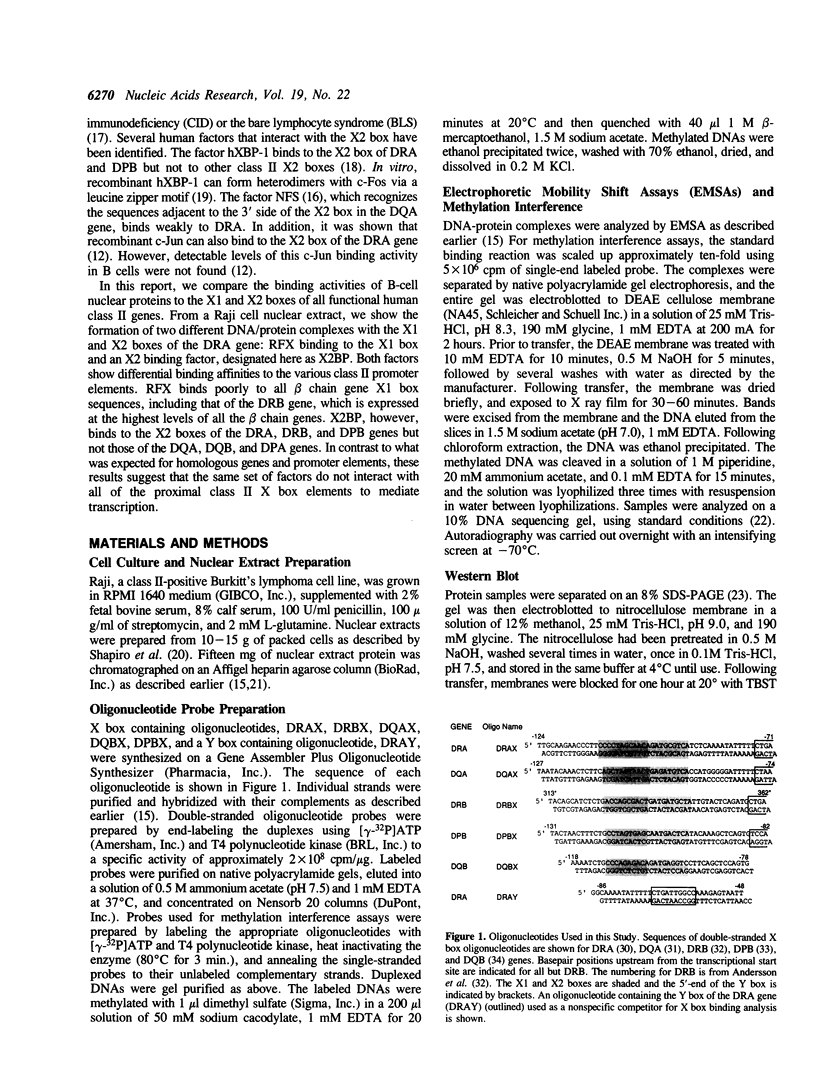
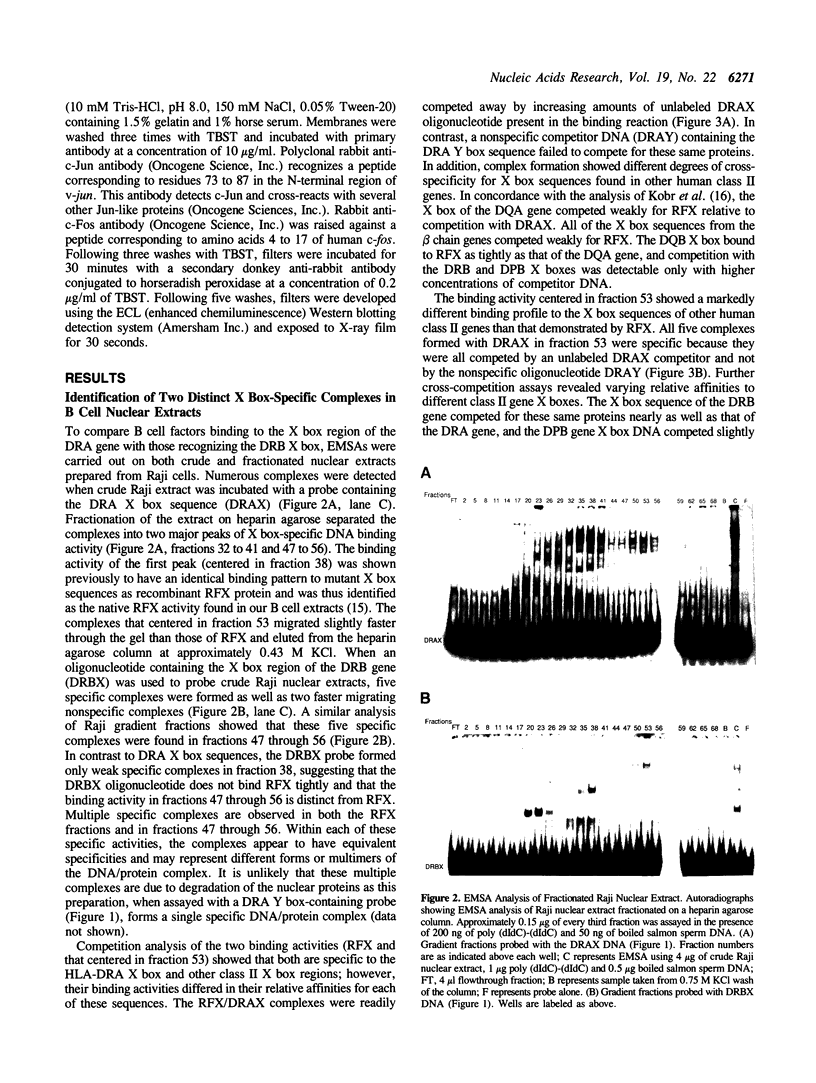
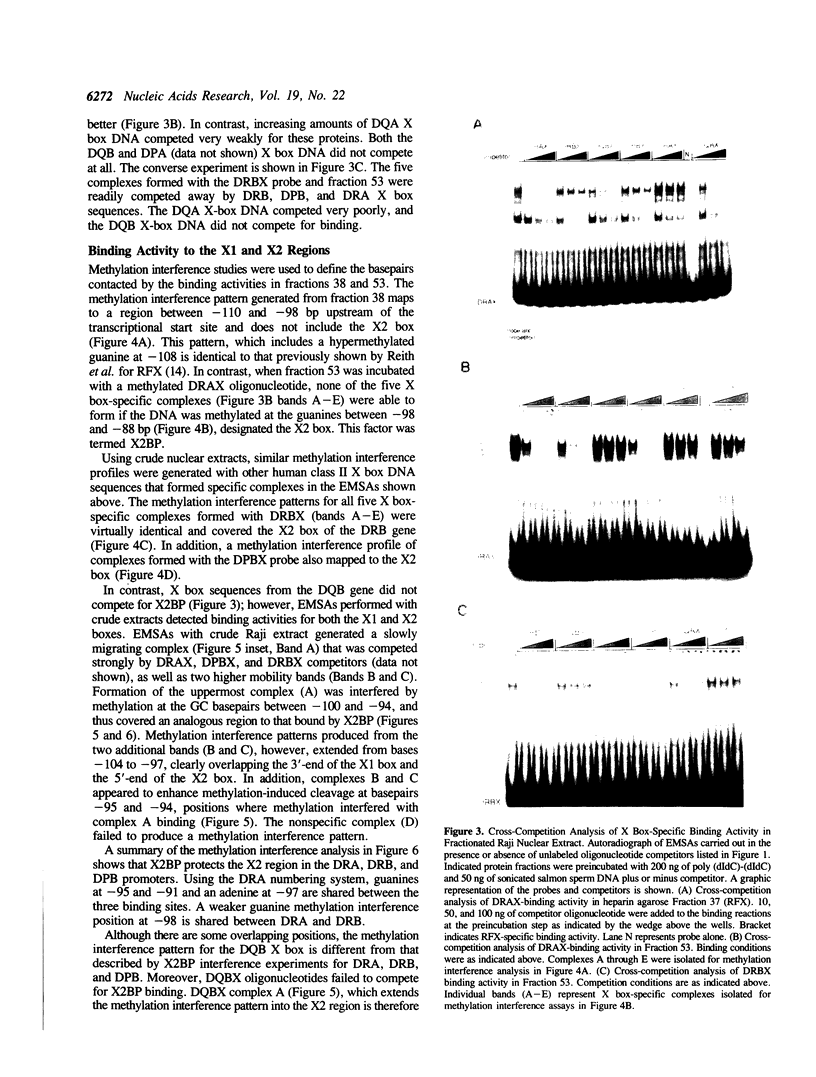
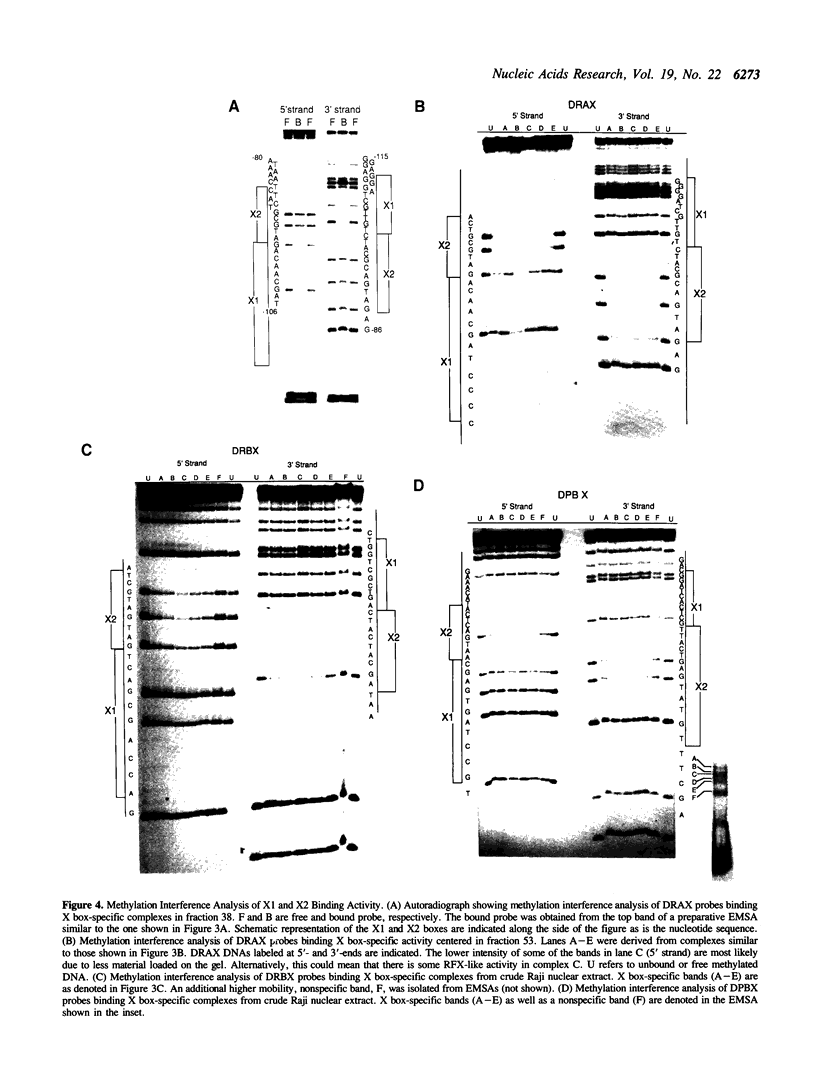
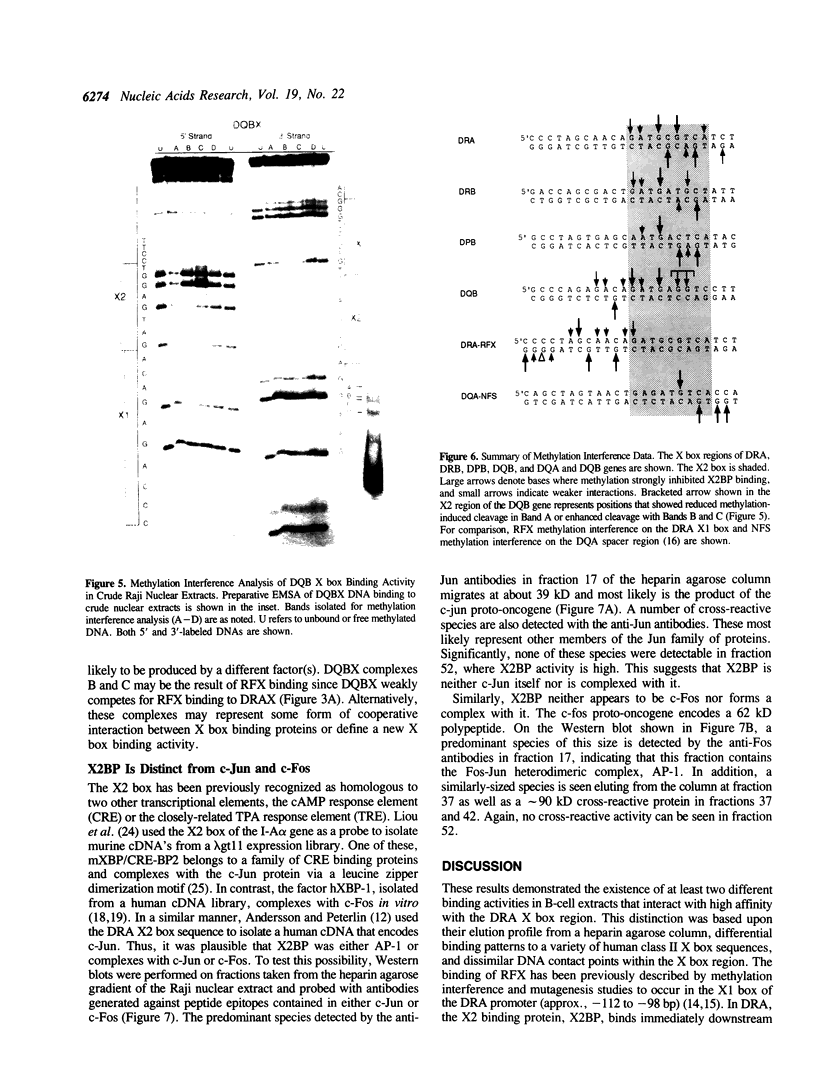
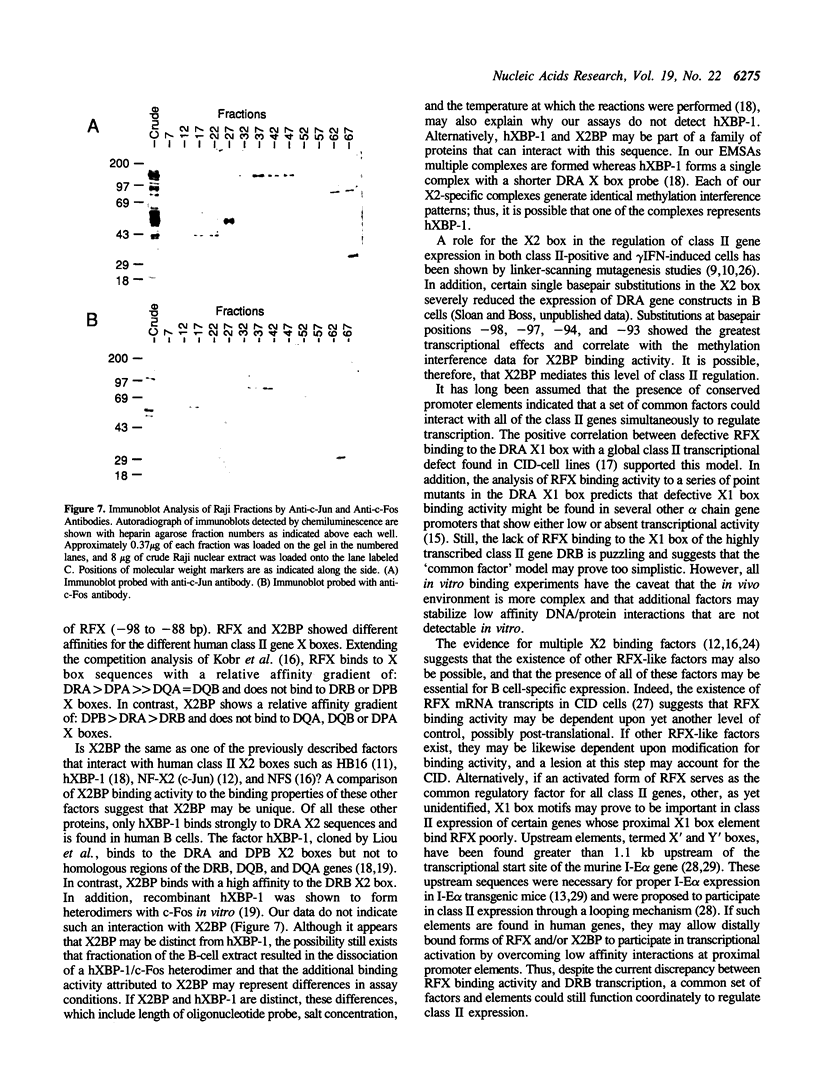
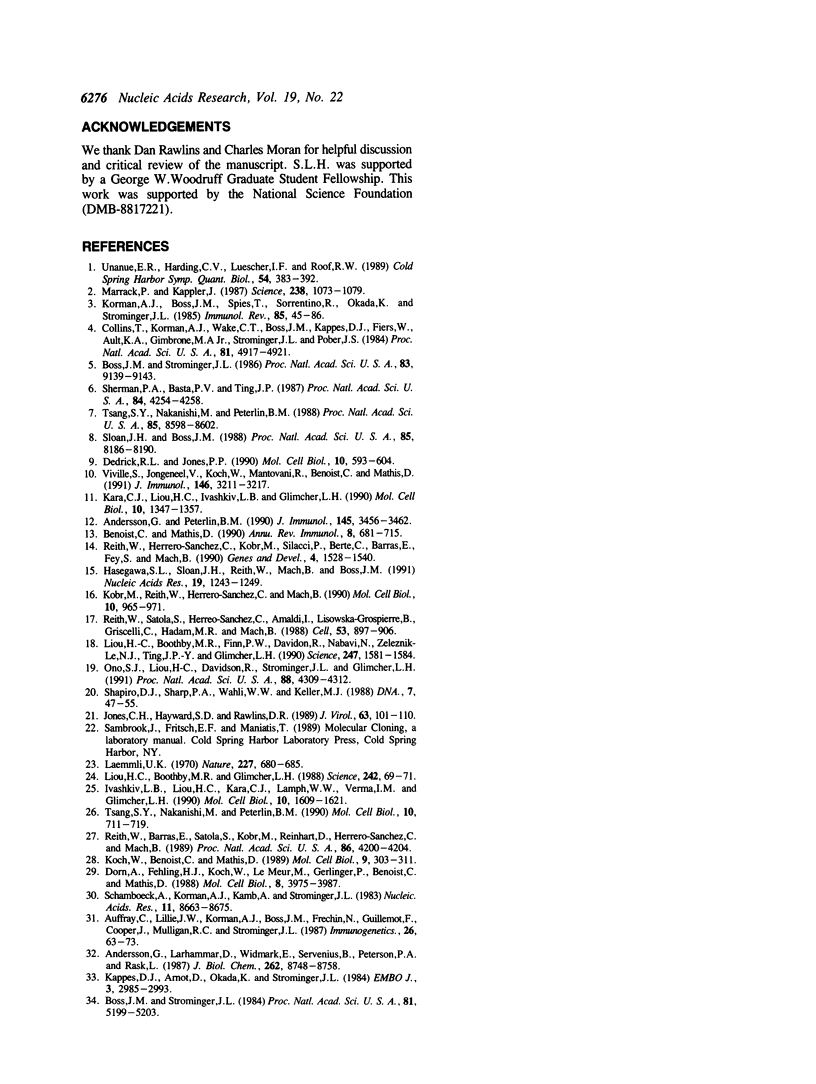
Images in this article
Selected References
These references are in PubMed. This may not be the complete list of references from this article.
- Andersson G., Larhammar D., Widmark E., Servenius B., Peterson P. A., Rask L. Class II genes of the human major histocompatibility complex. Organization and evolutionary relationship of the DR beta genes. J Biol Chem. 1987 Jun 25;262(18):8748–8758. [PubMed] [Google Scholar]
- Andersson G., Peterlin B. M. NF-X2 that binds to the DRA X2-box is activator protein 1. Expression cloning of c-Jun. J Immunol. 1990 Nov 15;145(10):3456–3462. [PubMed] [Google Scholar]
- Auffray C., Lillie J. W., Korman A. J., Boss J. M., Fréchin N., Guillemot F., Cooper J., Mulligan R. C., Strominger J. L. Structure and expression of HLA-DQ alpha and -DX alpha genes: interallelic alternate splicing of the HLA-DQ alpha gene and functional splicing of the HLA-DQ alpha gene using a retroviral vector. Immunogenetics. 1987;26(1-2):63–73. doi: 10.1007/BF00345456. [DOI] [PubMed] [Google Scholar]
- Benoist C., Mathis D. Regulation of major histocompatibility complex class-II genes: X, Y and other letters of the alphabet. Annu Rev Immunol. 1990;8:681–715. doi: 10.1146/annurev.iy.08.040190.003341. [DOI] [PubMed] [Google Scholar]
- Boss J. M., Strominger J. L. Cloning and sequence analysis of the human major histocompatibility complex gene DC-3 beta. Proc Natl Acad Sci U S A. 1984 Aug;81(16):5199–5203. doi: 10.1073/pnas.81.16.5199. [DOI] [PMC free article] [PubMed] [Google Scholar]
- Boss J. M., Strominger J. L. Regulation of a transfected human class II major histocompatibility complex gene in human fibroblasts. Proc Natl Acad Sci U S A. 1986 Dec;83(23):9139–9143. doi: 10.1073/pnas.83.23.9139. [DOI] [PMC free article] [PubMed] [Google Scholar]
- Collins T., Korman A. J., Wake C. T., Boss J. M., Kappes D. J., Fiers W., Ault K. A., Gimbrone M. A., Jr, Strominger J. L., Pober J. S. Immune interferon activates multiple class II major histocompatibility complex genes and the associated invariant chain gene in human endothelial cells and dermal fibroblasts. Proc Natl Acad Sci U S A. 1984 Aug;81(15):4917–4921. doi: 10.1073/pnas.81.15.4917. [DOI] [PMC free article] [PubMed] [Google Scholar]
- Dedrick R. L., Jones P. P. Sequence elements required for activity of a murine major histocompatibility complex class II promoter bind common and cell-type-specific nuclear factors. Mol Cell Biol. 1990 Feb;10(2):593–604. doi: 10.1128/mcb.10.2.593. [DOI] [PMC free article] [PubMed] [Google Scholar]
- Dorn A., Fehling H. J., Koch W., Le Meur M., Gerlinger P., Benoist C., Mathis D. B-cell control region at the 5' end of a major histocompatibility complex class II gene: sequences and factors. Mol Cell Biol. 1988 Oct;8(10):3975–3987. doi: 10.1128/mcb.8.10.3975. [DOI] [PMC free article] [PubMed] [Google Scholar]
- Hasegawa S. L., Sloan J. H., Reith W., Mach B., Boss J. M. Regulatory factor-X binding to mutant HLA-DRA promoter sequences. Nucleic Acids Res. 1991 Mar 25;19(6):1243–1249. doi: 10.1093/nar/19.6.1243. [DOI] [PMC free article] [PubMed] [Google Scholar]
- Ivashkiv L. B., Liou H. C., Kara C. J., Lamph W. W., Verma I. M., Glimcher L. H. mXBP/CRE-BP2 and c-Jun form a complex which binds to the cyclic AMP, but not to the 12-O-tetradecanoylphorbol-13-acetate, response element. Mol Cell Biol. 1990 Apr;10(4):1609–1621. doi: 10.1128/mcb.10.4.1609. [DOI] [PMC free article] [PubMed] [Google Scholar]
- Jones C. H., Hayward S. D., Rawlins D. R. Interaction of the lymphocyte-derived Epstein-Barr virus nuclear antigen EBNA-1 with its DNA-binding sites. J Virol. 1989 Jan;63(1):101–110. doi: 10.1128/jvi.63.1.101-110.1989. [DOI] [PMC free article] [PubMed] [Google Scholar]
- Kappes D. J., Arnot D., Okada K., Strominger J. L. Structure and polymorphism of the HLA class II SB light chain genes. EMBO J. 1984 Dec 1;3(12):2985–2993. doi: 10.1002/j.1460-2075.1984.tb02245.x. [DOI] [PMC free article] [PubMed] [Google Scholar]
- Kara C. J., Liou H. C., Ivashkiv L. B., Glimcher L. H. A cDNA for a human cyclic AMP response element-binding protein which is distinct from CREB and expressed preferentially in brain. Mol Cell Biol. 1990 Apr;10(4):1347–1357. doi: 10.1128/mcb.10.4.1347. [DOI] [PMC free article] [PubMed] [Google Scholar]
- Kobr M., Reith W., Herrero-Sanchez C., Mach B. Two DNA-binding proteins discriminate between the promoters of different members of the major histocompatibility complex class II multigene family. Mol Cell Biol. 1990 Mar;10(3):965–971. doi: 10.1128/mcb.10.3.965. [DOI] [PMC free article] [PubMed] [Google Scholar]
- Koch W., Benoist C., Mathis D. Anatomy of a new B-cell-specific enhancer. Mol Cell Biol. 1989 Jan;9(1):303–311. doi: 10.1128/mcb.9.1.303. [DOI] [PMC free article] [PubMed] [Google Scholar]
- Korman A. J., Boss J. M., Spies T., Sorrentino R., Okada K., Strominger J. L. Genetic complexity and expression of human class II histocompatibility antigens. Immunol Rev. 1985 Jul;85:45–86. doi: 10.1111/j.1600-065x.1985.tb01130.x. [DOI] [PubMed] [Google Scholar]
- Laemmli U. K. Cleavage of structural proteins during the assembly of the head of bacteriophage T4. Nature. 1970 Aug 15;227(5259):680–685. doi: 10.1038/227680a0. [DOI] [PubMed] [Google Scholar]
- Liou H. C., Boothby M. R., Finn P. W., Davidon R., Nabavi N., Zeleznik-Le N. J., Ting J. P., Glimcher L. H. A new member of the leucine zipper class of proteins that binds to the HLA DR alpha promoter. Science. 1990 Mar 30;247(4950):1581–1584. doi: 10.1126/science.2321018. [DOI] [PubMed] [Google Scholar]
- Liou H. C., Boothby M. R., Glimcher L. H. Distinct cloned class II MHC DNA binding proteins recognize the X box transcription element. Science. 1988 Oct 7;242(4875):69–71. doi: 10.1126/science.3140376. [DOI] [PubMed] [Google Scholar]
- Marrack P., Kappler J. The T cell receptor. Science. 1987 Nov 20;238(4830):1073–1079. doi: 10.1126/science.3317824. [DOI] [PubMed] [Google Scholar]
- Ono S. J., Liou H. C., Davidon R., Strominger J. L., Glimcher L. H. Human X-box-binding protein 1 is required for the transcription of a subset of human class II major histocompatibility genes and forms a heterodimer with c-fos. Proc Natl Acad Sci U S A. 1991 May 15;88(10):4309–4312. doi: 10.1073/pnas.88.10.4309. [DOI] [PMC free article] [PubMed] [Google Scholar]
- Reith W., Barras E., Satola S., Kobr M., Reinhart D., Sanchez C. H., Mach B. Cloning of the major histocompatibility complex class II promoter binding protein affected in a hereditary defect in class II gene regulation. Proc Natl Acad Sci U S A. 1989 Jun;86(11):4200–4204. doi: 10.1073/pnas.86.11.4200. [DOI] [PMC free article] [PubMed] [Google Scholar]
- Reith W., Herrero-Sanchez C., Kobr M., Silacci P., Berte C., Barras E., Fey S., Mach B. MHC class II regulatory factor RFX has a novel DNA-binding domain and a functionally independent dimerization domain. Genes Dev. 1990 Sep;4(9):1528–1540. doi: 10.1101/gad.4.9.1528. [DOI] [PubMed] [Google Scholar]
- Reith W., Satola S., Sanchez C. H., Amaldi I., Lisowska-Grospierre B., Griscelli C., Hadam M. R., Mach B. Congenital immunodeficiency with a regulatory defect in MHC class II gene expression lacks a specific HLA-DR promoter binding protein, RF-X. Cell. 1988 Jun 17;53(6):897–906. doi: 10.1016/s0092-8674(88)90389-3. [DOI] [PubMed] [Google Scholar]
- Schamboeck A., Korman A. J., Kamb A., Strominger J. L. Organization of the transcriptional unit of a human class II histocompatibility antigen: HLA-DR heavy chain. Nucleic Acids Res. 1983 Dec 20;11(24):8663–8675. doi: 10.1093/nar/11.24.8663. [DOI] [PMC free article] [PubMed] [Google Scholar]
- Shapiro D. J., Sharp P. A., Wahli W. W., Keller M. J. A high-efficiency HeLa cell nuclear transcription extract. DNA. 1988 Jan-Feb;7(1):47–55. doi: 10.1089/dna.1988.7.47. [DOI] [PubMed] [Google Scholar]
- Sherman P. A., Basta P. V., Ting J. P. Upstream DNA sequences required for tissue-specific expression of the HLA-DR alpha gene. Proc Natl Acad Sci U S A. 1987 Jun;84(12):4254–4258. doi: 10.1073/pnas.84.12.4254. [DOI] [PMC free article] [PubMed] [Google Scholar]
- Sloan J. H., Boss J. M. Conserved upstream sequences of human class II major histocompatibility genes enhance expression of class II genes in wild-type but not mutant B-cell lines. Proc Natl Acad Sci U S A. 1988 Nov;85(21):8186–8190. doi: 10.1073/pnas.85.21.8186. [DOI] [PMC free article] [PubMed] [Google Scholar]
- Tsang S. Y., Nakanishi M., Peterlin B. M. B-cell-specific and interferon-gamma-inducible regulation of the HLA-DR alpha gene. Proc Natl Acad Sci U S A. 1988 Nov;85(22):8598–8602. doi: 10.1073/pnas.85.22.8598. [DOI] [PMC free article] [PubMed] [Google Scholar]
- Tsang S. Y., Nakanishi M., Peterlin B. M. Mutational analysis of the DRA promoter: cis-acting sequences and trans-acting factors. Mol Cell Biol. 1990 Feb;10(2):711–719. doi: 10.1128/mcb.10.2.711. [DOI] [PMC free article] [PubMed] [Google Scholar]
- Unanue E. R., Harding C. V., Luescher I. F., Roof R. W. Antigen-binding function of class II MHC molecules. Cold Spring Harb Symp Quant Biol. 1989;54(Pt 1):383–392. doi: 10.1101/sqb.1989.054.01.047. [DOI] [PubMed] [Google Scholar]
- Viville S., Jongeneel V., Koch W., Mantovani R., Benoist C., Mathis D. The E alpha promoter: a linker-scanning analysis. J Immunol. 1991 May 1;146(9):3211–3217. [PubMed] [Google Scholar]







